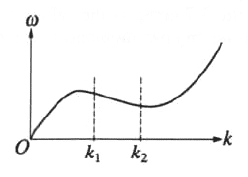\prob{79}

The dispersion curve shown above relates the angular frequency  to the wave number k. For waves with wave numbers lying in the range $k_1 to the wave number k. For waves with wave numbers lying in the range $k_1
- They are in opposite directions.
- They are in the same direction and the phase velocity is larger
- They are in the same direction and the group velocity is larger
- The phase velocity is infinite and the group velocity is finite.
- They are the same in direction and magnitude
|
Wave Phenomena }Group Velocity }Group Velocity
Recall that the group velocity is given by  and the phase velocity is given by and the phase velocity is given by  . .
In the region between  and and  , the derivative is a constant negative quantity (approximately just the derivative of a line with negative slope). However, , the derivative is a constant negative quantity (approximately just the derivative of a line with negative slope). However,  is positive in this region. Thus, the phase and group velocity are traveling in opposite directions. Thus, choose choice (A). is positive in this region. Thus, the phase and group velocity are traveling in opposite directions. Thus, choose choice (A).
|
